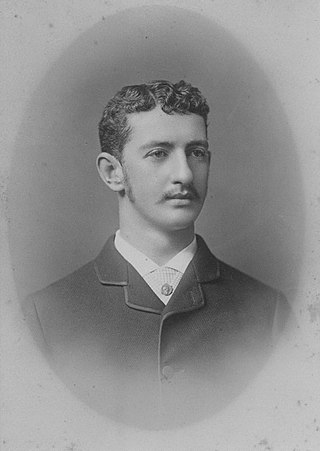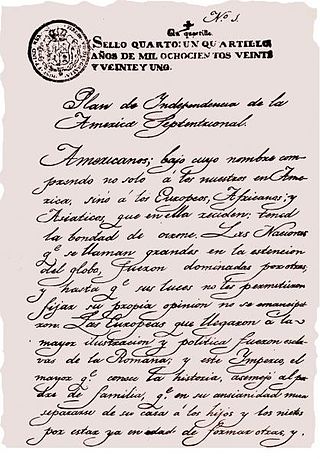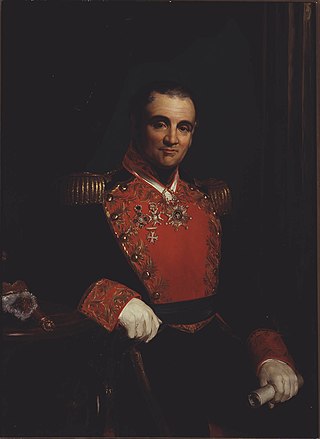| |||||
| Decades: | |||||
|---|---|---|---|---|---|
| See also: | |||||
Events in the year 1821 in Mexico.
| |||||
| Decades: | |||||
|---|---|---|---|---|---|
| See also: | |||||
Events in the year 1821 in Mexico.

The United Mexican States is a federal republic composed of 32 federal entities: 31 states and Mexico City, an autonomous entity. According to the Constitution of 1917, the states of the federation are free and sovereign in all matters concerning their internal affairs. Each state has its own congress and constitution.

Agustín Cosme Damián de Iturbide y Arámburu, commonly known as Agustín de Iturbide and later by his regnal name Agustín I, was the first Emperor of Mexico from 1822 until his abdication in 1823. An officer in the royal Spanish army, during the Mexican War of Independence he initially fought insurgent forces rebelling against the Spanish crown before changing sides in 1820 and leading a coalition of former royalists and long-time insurgents under his Plan of Iguala. The combined forces under Iturbide brought about Mexican independence in September 1821. After securing the secession of Mexico from Spain, Iturbide was proclaimed president of the Regency in 1821; a year later, he was proclaimed Emperor, reigning from 19 May 1822 to 19 March 1823, when he abdicated. In May 1823 he went into exile in Europe. When he returned to Mexico in July 1824, he was arrested and executed.

Agustín de Iturbide y Green was the grandson of Agustín de Iturbide, the first emperor of independent Mexico, and his consort Ana María Huarte.

Guadalupe Victoria, born José Miguel Ramón Adaucto Fernández y Félix, was a Mexican general and politician who fought for independence against the Spanish Empire in the Mexican War of Independence and after the adoption of the Constitution of 1824, was elected as the first president of the United Mexican States. He was a deputy in the Mexican Chamber of Deputies for Durango and a member of the Supreme Executive Power following the downfall of the First Mexican Empire, which was followed by the 1824 Constitution and his presidency. He later served as Governor of Puebla.

The Plan of Iguala, also known as The Plan of the Three Guarantees or Act of Independence of North America, was a revolutionary proclamation promulgated on 24 February 1821, in the final stage of the Mexican War of Independence from Spain. The Plan stated that Mexico was to become a constitutional monarchy, whose sole official religion would be Roman Catholicism, in which both the Peninsulares and the Americanos would enjoy equal political and social rights. It took its name from the city of Iguala in the modern-day state of Guerrero.

The Mexican Empire was a constitutional monarchy and the first independent government of Mexico. It was also the only former viceroyalty of the Spanish Empire to establish a monarchy after gaining independence. The empire existed from 1821 to 1823, making it one of the few modern-era independent monarchies in the Americas, alongside the Empire of Brazil (1822–1889) and the First Empire of Haiti (1804–1806).

The Mexican War of Independence was an armed conflict and political process resulting in Mexico's independence from the Spanish Empire. It was not a single, coherent event, but local and regional struggles that occurred within the same period, and can be considered a revolutionary civil war. It culminated with the drafting of the Declaration of Independence of the Mexican Empire in Mexico City on September 28, 1821, following the collapse of royal government and the military triumph of forces for independence.

The Treaty of Córdoba established Mexican independence from Spain at the conclusion of the Mexican War of Independence. It was signed on August 24, 1821 in Córdoba, Veracruz, Mexico. The signatories were the head of the Army of the Three Guarantees, Agustín de Iturbide, and, acting on behalf of the Spanish government, Jefe Político Superior Juan O'Donojú. The treaty has 17 articles, which developed the proposals of the Plan of Iguala. The Treaty is the first document in which Spanish and Mexican officials accept the liberty of what will become the First Mexican Empire, but it is not today recognized as the foundational moment, since these ideas are often attributed to the Grito de Dolores. The treaty was rejected by the Spanish government, publishing this determination in Madrid on February 13 and 14, 1822.

At the end of the Mexican War of Independence, the Army of the Three Guarantees was the name given to the army after the unification of the Spanish troops led by Agustín de Iturbide and the Mexican insurgent troops of Vicente Guerrero, consolidating Mexico's independence from Spain. The decree creating this army appeared in the Plan de Iguala, which stated the three guarantees which it was meant to defend were religion, independence and unity. Mexico was to be a Catholic empire, independent from Spain, and united against its enemies.

Trinidad Anastasio de Sales Ruiz Bustamante y Oseguera was a Mexican physician, general, and politician who served as the 4th President of Mexico three times from 1830 to 1832, 1837 to 1839, and 1839 to 1841. He also served as the 2nd Vice President of Mexico from 1829 to 1832 under Presidents Vicente Guerrero, José María Bocanegra, himself, and Melchor Múzquiz. He participated in the Mexican War of Independence initially as a royalist before siding with Agustín de Iturbide and supporting the Plan of Iguala.

María Josepha Sophia de Iturbide was the head of the Imperial House of Mexico from 1925 to 1949. A modest and very religious lady, she played no political role whatsoever. She married twice and had two daughters.

Agustín Jerónimo de Iturbide y Huarte was the eldest son of the first Emperor of Mexico, Agustín I of Mexico. He was the heir apparent to the First Mexican Empire and a member of the Imperial House of Iturbide. Later in life, he served as a military officer in South America and also worked as a diplomat for the United Mexican States at the Mexican embassy in the United States and in London, after his military career had ended in South America.

The House of Iturbide is a former Imperial House of Mexico. It was founded by the Sovereign Mexican Constituent Congress on 22 June 1822 when the newly independent Mexican congress confirmed Agustín I's title of Constitutional Emperor of Mexico. He was baptized with the names of Saints Augustine, Cosmas, and Damian at the cathedral there. The last name Iturbide was originally from the Basque Country, Spain. Emperor Agustín abdicated and lived in exile with the prohibition on returning to Mexico. Despite that ban, he returned, was captured, and executed. Grandchildren of Emperor Agustín were adopted by Maximilian I of Mexico (1864–67), who had no biological children, and granted some status in the ephemeral Second Mexican Empire.

The Palace of Iturbide is a large palatial residence located in the historic center of Mexico City at Madero Street #17. It was built by the Count of San Mateo Valparaíso as a wedding gift for his daughter. It gained the name “Palace of Iturbide” because Agustín de Iturbide lived there and accepted the crown of the First Mexican Empire at the palace after independence from Spain. Today, the restored building houses the Fomento Cultural Banamex; it has been renamed the Palacio de Cultura Banamex.

The Declaration of Independence of the Mexican Empire is the document by which the Mexican Empire declared independence from the Spanish Empire. This founding document of the Mexican nation was drafted in the National Palace in Mexico City on September 28, 1821, by Juan José Espinosa de los Monteros, secretary of the Provisional Governmental Board.
In the history of Mexico, the Plan of Veracruz was a call to revolt against Emperor of Mexico Augustín de Iturbide, proclaimed by Antonio Lopez de Santa Anna at the port of Mexico on December 2, 1822. It was ratified on December 6.
Maximilian Graf von Götzen-Iturbide is a Hungarian-born businessman. He is the current head of the Imperial House of Mexico, since the death of his grandmother, María de Iturbide, in November 1949. He is a great-great-grandson of Emperor Agustín I of Mexico.

The Regency of the Mexican Empire was a period of transition in the history of the Mexican monarchy in the absence of the Emperor of Mexico and presided by a president of the same during the First Mexican Empire (1821–1823) and the Second Mexican Empire (1863–1867). The regency is the government of a State during the minor age, absence or incapacity of its legitimate prince.

Joseph Anton Lopez was a Mexican Catholic priest and Jesuit. Born in Michoacán, he studied canon law at the Colegio de San Nicolás and the Royal and Pontifical University of Mexico. He became acquainted with the future Empress consort Ana María Huarte and was made chaplain to the future imperial family. He was later put in charge of the education of all the princes in Mexico. Lopez was a close ally of Emperor Agustín de Iturbide, residing in Madrid for four years as his attorney and political informant, and accompanying him during his exile to Italy and England.

From January 1822 to July 1823, the Captaincy General of Guatemala, a former Spanish colony, was controlled by the First Mexican Empire, and briefly, the Supreme Executive Power—the provisional government that succeeded Mexican imperial rule. The captaincy general consisted of the provinces of Chiapas, Costa Rica, El Salvador, Guatemala, Honduras, and Nicaragua—the six southernmost provinces of the Mexican Empire. The incorporation of Central America brought Mexico to the height of its territorial extent.